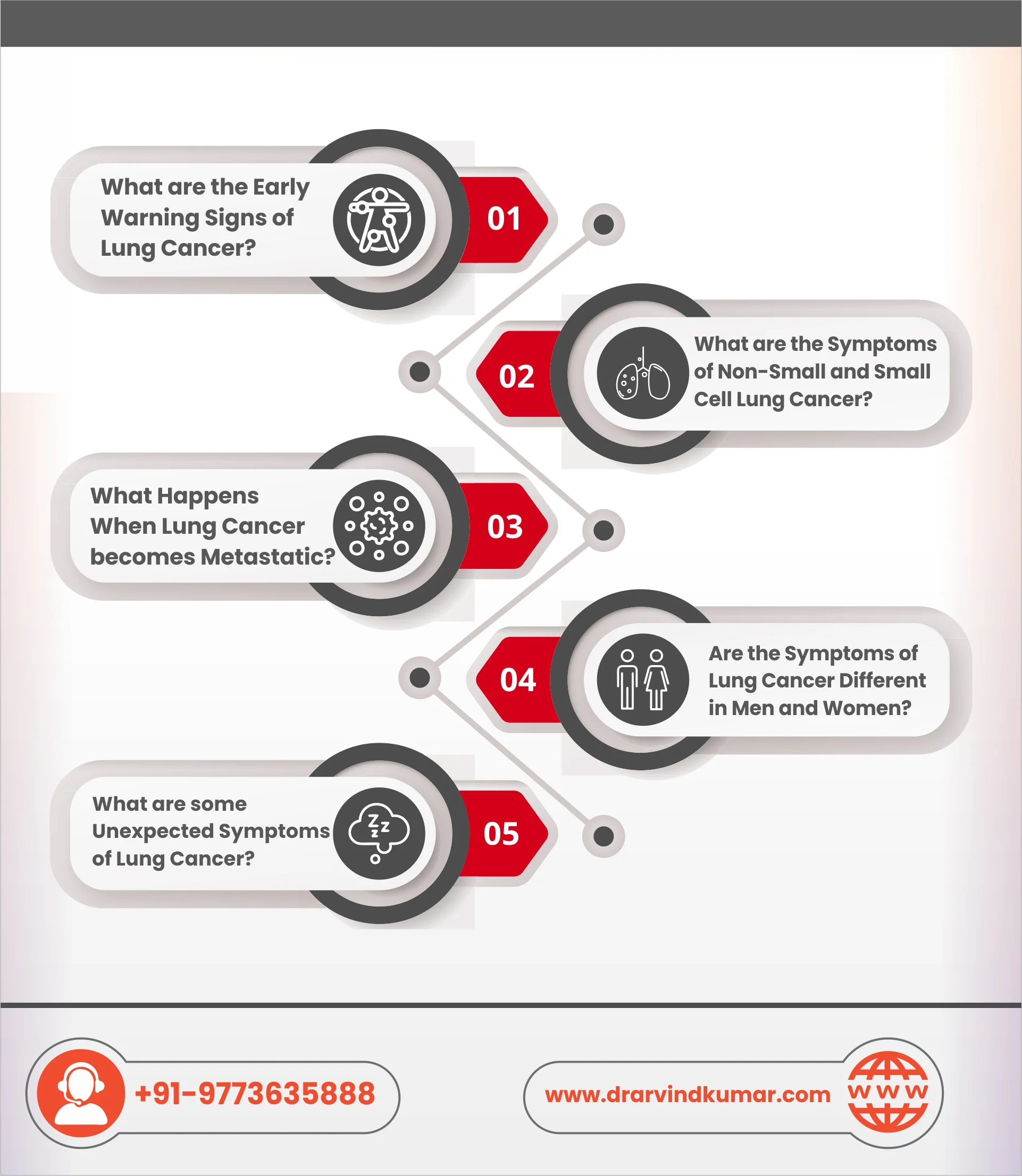Every year, over 2.2 million lung cancer cases are diagnosed and treated worldwide. Lung cancer leads to the greatest fatalities compared to the other types of cancers, accounting for an estimated 1.8 million deaths each year.
But why is that the case? Despite the advancements in modern medicine, lung cancer is often diagnosed at a later stage. The signs and symptoms of lung cancer are to be blamed since they don’t appear until the cancer has already progressed.
This article will explore some early warning signs of lung cancer that we often brush to the side.
What are the Early Warning Signs of Lung Cancer?
You will seldom come across patients with lung cancer diagnosed in their earlier stages. It’s because symptoms like a cough, tightness in the chest, heavy breathing, etc., are very common symptoms that no one takes seriously until things turn for the worse.
If you have a risk factor or a genetic predisposition to developing lung cancer, prioritizing the early lung cancer symptoms is crucial. The risk facts include those with history of smoking as as
Some of the most notable signs are:
- A persistent chronic cough that doesn’t recover
- Sharp, shooting pain in the chest and back when breathing, coughing, etc.
- Cough with blood and phlegm discharge
- Shortness of breath
- Losing weight without trying
- Constant bout of fatigue
- Sudden loss of appetite
- Recurring lung infection symptoms
- Wheezing or hoarseness in the voice
- Feeling pain when swallowing food or drinks
- Finger clubbing (very rare)
These symptoms are often associated with a variety of other diseases too. However, since they could potentially be symptoms of lung cancer, it is ideal to see a doctor to confirm the diagnosis.
What are the Symptoms of Non-Small and Small Cell Lung Cancer?
Regarding distinguishing types of lung cancer in patients, there are two primary types.
Non-Small Cell Lung cancer (NSCLC) – Cancer develops at a slower pace, producing the symptoms at a later stage when it has already progressed a lot.
Small Cell Lung cancer (SCLC) – This more aggressive form of lung cancer leads to the formation of malignant cancer cells in the lining of the lung tissues.
Here are all the important symptoms you should be aware of:
| Non-Small Cell Lung Cancer Symptoms | Small Cell Lung Cancer Symptoms |
| – Persistent cough
-Coughing with bloody discharge -Shortness of breath -Pain in the chest -Fatigue -Wheezing or hoarseness in the voice -Recurring upper respiratory infections -Pain in the joints and bone -Nerve damage (in advanced stage) -Paraneoplastic syndromes (in advanced stage) |
-Persistent cough
-Chest pain -Unexplained weight loss and appetite -Coughing with blood discharge and phlegm -Shortness of breath -Fatigue and tiredness -Recurring lung infections -Headaches and dizziness -Jaundice (in advanced stage) -Lumps in the neck (advanced stage) |
Besides these symptoms, many patients with NSCLC and SCLC also experience paraneoplastic syndromes or accessory symptoms that directly don’t affect the respiratory functions. Some of those symptoms include muscle weakness and pain, excess calcium build-up in the blood, muscle cramps, etc.
What Happens When Lung Cancer becomes Metastatic?
Metastasis is when the lung cancer cells start migrating out of their form of origin. So, if lung cancer originates in the lungs, as cancer progresses, these cancerous cells start affecting the nearby cells and the other organs, leading to advanced stages of cancer.
The symptoms of metastatic lung cancer depend on where the cancerous cells have spread. The symptoms are generally prevalent in about 30-40% of patients, while the rest don’t feel any potential early signs of lung cancer metastasis.
Some of the most concerning symptoms of metastasized lung cancer are:
- Bone pain
- Fractures
- Decreased alertness (due to hypercalcemia)
- Constipation
- Nausea
- Extreme fatigue
- Enlarged abdominal girth
- Swelling in the feet and ankles
- Yellowing skin (signs of jaundice)
- Headache
- Blurry vision
- Difficulty with speech
- Seizures
Paying attention to any or multiple of these symptoms is essential for an earlier diagnosis and getting the patient on the right treatment plan.

Are the Symptoms of Lung Cancer Different in Men and Women?
Lung cancer accounts for the most cancer deaths (in both men and women). But are the symptoms similar in either gender?
Although women are often diagnosed earlier with lung cancer than men, the symptoms of lung cancer in men and women are pretty much the same.
The difference in the symptoms depends on the type of lung cancer the patient is diagnosed with.
Common symptoms of lung cancer in women and men due to squamous cell carcinoma are:
- Recurrent and chronic cough
- Tightness and pain in the chest
- Loss of appetite
- Sudden weight loss
- Difficult or feeling pain when swallowing
- Swelling in the neck veins
Women who are diagnosed with adenocarcinoma experience pain in the back as well. This is a symptom that is more prevalent in women than in men.
What are some Unexpected Symptoms of Lung Cancer?
All the above symptoms or first signs of lung cancer we discussed are very common knowledge. Even if you aren’t well-versed with the condition, these are some of the signs that could alarm you about a possible complication in the body.
But what about the unexpected symptoms no one correlates with lung cancer? These symptoms are generally non-respiratory, meaning they don’t affect the lungs and the associated areas.
However, awareness of these symptoms is crucial for an early diagnosis and treatment. Some of the most important signs are:
Experiencing pain in the arm – Pancost tumor, a type of lung cancer, develops in the upper portion of the lungs and lead to nerve damage in the ribs, vertebrae, etc., leading to pain and discomfort in the arms and shoulders. It also leads to numbness and tingling sensations in the arms.
Balance issues – If you are unstable in stature, that is another potential sign of lung cancer. This could be due to obstruction by a tumor in the superior vena cava, leading to balance problems, dizziness, etc.
Blood clots – Lung cancer markers increase inflammation in the body, which can irrevocably lead to complications of blood clots. Not just in the lungs, these clots can form in the arms and legs of the patient too.
Clubbed fingers – Fatter fingers are an unconventional sign of lung cancer that few people pay attention to. It leads to the appearance of a fatter finger around the tips, along with shiny nails. Studies indicate that around 80% of people with lung cancer experience this symptom.
Digestive complications – Most lung cancer patients struggle with hypercalcemia or high calcium levels in their blood. This is an alarming complication that often leads to risks of digestive complications.
Heart complications – The prevalence of high calcium levels in lung cancer patients inadvertently lead to heart problems like arrhythmia, tachycardia, etc. If left untreated, these can lead to heart attack risks.
Swollen breasts in men – Large cell lung cancer often leads to hormonal imbalance in men, which can lead to swelling and tenderness in the chest region of a man.
Mental health complications – Conditions like anxiety, depression, and dementia are often heightened in patients with lung cancer. There aren’t many conclusive studies to draw the reason why.
Conclusion
Lung Cancer isn’t always terminal and is treatable if diagnosed correctly. At Medanta, we aim to fast-track your diagnosis and offer you a comprehensive and effective treatment that can improve your quality of life and offer you a second chance at fighting such a fatal disease.
If you are experiencing any symptoms that shouldn’t be there in the first place, don’t hesitate to book a consultation. Sometimes, it’s better to be informed than stay oblivious about the situation.
For further details, refer to this video. For queries and consultations, visit https://drarvindkumar.com/contact-us.php.
FAQs
How long can you have lung cancer without knowing?
Studies indicate that some types of lung cancers can remain dormant in the body for up to 20 years, after which it can progress very quickly and become an aggressive form of cancer.
Does lung cancer show up in blood tests?
Blood tests aren’t enough to conclude a diagnosis of lung cancer. However, they can help assess any potential complications due to lung cancer, including higher inflammatory markers in the body.

.webp)



